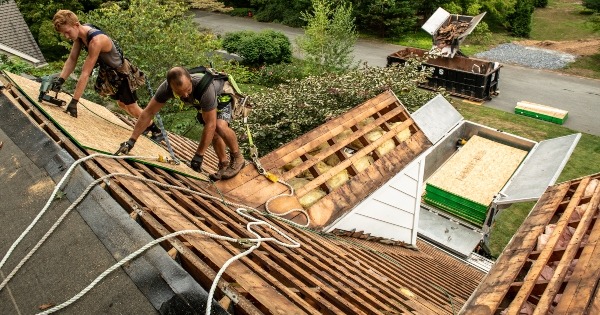Roofing process

What to expect after you sign a contract with a roofing contractor.
So you found a roofer and you're project is about to begin, but you are a bit nervous about what comes next. At AskARoofer we know that this can be overwhelming when you don't have any background in the roofing industry, which is why we've created the following guide to answer all your roof questions and installation concerns.
Before the project begins
- Check with your surrounding community for any restrictions on traffic and noise. If this is a residential roofing project, make sure to check with any homeowner associations or similar organizations in your neighborhood.
- Before the contracting company's crew starts the installation, make sure they have delivered the exact roofing products that you ordered/chose.
- Put away or cover pots, outdoor furniture, lighting, garden decorations and so forth that could be damaged during installation.
- Your roofer might need to store some materials and equipment in your driveway or in the street in front of your home. Be prepared to make room for the materials and have limited access for a few days.
- The crew on site may need access to electricity, so it's advised that you locate a convenient plug for them.
- Remember it is hard for your contractor to identify certain roof problems (such as roof damage to the wood underneath the shingles) until the process begins. Be sure to go over worst case scenario and costs with your contractor before starting the job to minimize any surprises.
- Discuss the desired route and process of delivering materials from their storage space to the roof. Sometimes access to the roof cannot be obtained by the driveway and the only way to deliver the materials to the roof is by equipment driving on your lawn or plant materials, which may cause some damage. Minimize this by working with your contractor to make sure important, high cost things (such sprinklers and important plant materials) are avoided when possible.
During the project
- If you won’t be home, make sure your contractor has your contact information.
- There is a lot of noise when tearing off or re-installing a roof -- hammering, hammering and more hammering. You may hear saws running and what may sound like elephants on your roof. You may even see dust coming out of your light fixtures, but don’t be alarmed, this is all normal.
- Secure any valuable and fragile items, inside and outside your home. There will be a lot of vibrations from the work, so remove pictures from your walls that you don't want to be damaged. Also, be aware that all of the ruckus may set off your security alarms.
- If they are removing the old roof, it will get dusty in the house as the debris and dirt get into your ventilation system. Additionally, things stored in the attic might get temporarily exposed to the outdoors, leaving them vulnerable. Depending on work being done, you need to consider fumes and think about setting up fans to keep the interior of your home healthy.
- This one is very true for roof maintenance as well, but there will be contractors and ladders around your property. Please be aware that they may need access to gates to get around your house and those gates may need to be kept open. If you have pets they may need to be secured.
- Debris will be falling off the roof all around your house. For safety reasons, keep children, guests and animals clear of the installation area.
- If your contractor was required to pull a permit you will have an inspection from your local city official. Nothing will be required from you. This will all be handled by your contractor.
- Do not let your contractor leave your roof torn off and open to the elements overnight. They should cover it up with an underlayment or a tarp.
- Your contractor should clean up after finishing for the day. Ask them to sweep the area with a nail magnet if they have not already showcased a debris collection device (such as the Catch-All).
After the project is complete
- Make sure all warranty information is correctly filled out and submitted.
- Before you pay the final payment make sure you have all the labor and material lien releases.
- Walk the job with your contractor and address any concerns and questions you may have. Know that many people find a roofer through referrals, so if you are happy with the work on your house consider leaving a recommendation online!
Overall, the roofing process is a messy one that can make a surprising amount of noise and debris. But it is definitely worth it at the end of the day when you are resting, safe and secure, beneath a beautiful new roof.
Learn more about the roofing industry in general.
Find your local roofing contractor in the AskARooferTM Contractor Directory.
Have a question? AskARoofer.
Photo courtesy of: Equipter









